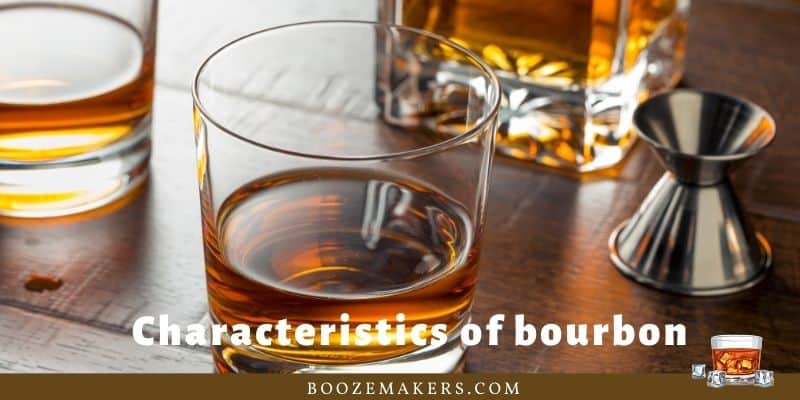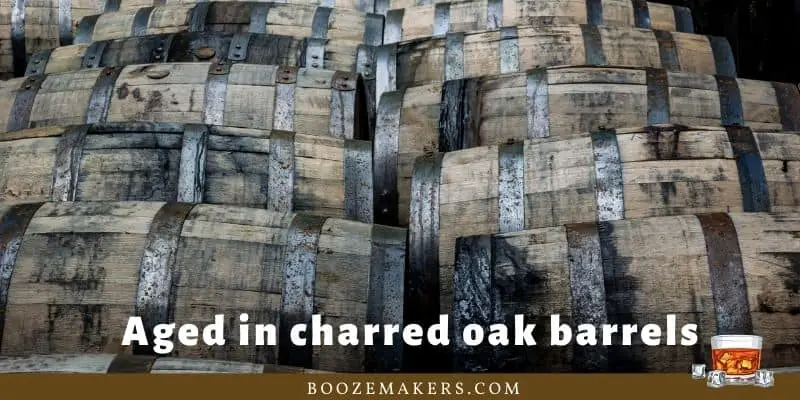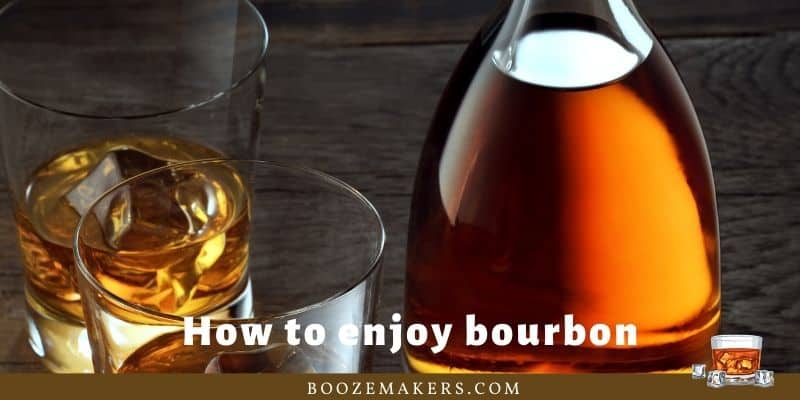Unless you are a dedicated whiskey drinker, you might think that bourbon and whiskey are pretty much the same. After all, both spirits share the same deep, rich golden-brown hue and have a similar flavor character.
But to be more accurate, bourbon is only one of many different types of distillates known as whiskeys. Yes, you read that right: bourbon IS a type of whiskey. So although you might not be off the mark when you refer to a bottle of bourbon as a ‘whiskey’, not every whiskey you come across is bourbon.
Confused? A quick definition of both should clear up the differences!
Whiskey versus bourbon
Whiskey is a type of spirit distilled from several different types of grain, including wheat, rye, barley, and corn. The mixture of these grains–called ‘mash’–is fermented and placed in wooden barrels to age.
As you can imagine, there are many different varieties of whiskeys made all over the world, including Scotch and Irish whiskey, which are distilled in Scotland and Ireland, respectively.
There are also a few different whiskey types distilled in the United States, one of which is bourbon.
Bourbon has had quite an interesting and colorful past, even as only one chapter in the broader history of whiskeys. Although it has since achieved recognition as one of the great American spirits, it wasn’t always as highly regarded as it is today.
When bourbon was introduced in the early to mid-1900s, it was widely considered “bottom of the barrel”, and for good reason. The earliest bourbons were inexpensive, of inferior quality, and quite bitter.
But thanks to the dedication and hard work of Bill and Marge Samuels of Maker’s Mark Distillery, bourbon underwent a significant flavor revamp. The husband-and-wife team’s new recipe changed the flavor profile of bourbon for the better and paved the way for the respectability that the spirit enjoys today.
Characteristics of bourbon

Like all whiskeys, bourbon has its unique qualities and characteristics. It is also subject to a few requirements, including the following:
- It has to be distilled in the United States
- It must have at least 51% corn content
- It should be aged in charred oak barrels
- It must be distilled to 160 proof at most
- When placed into the barrel, it should be 125 proof at most
- When bottled, it should be at least 80 proof
- It must not have flavoring, coloring, or any other additives
Let’s take a look at some of these characteristics in closer detail.
51% corn content
The manufacturing and aging processes are what primarily distinguish bourbon from other types of whiskeys. Of course, all whiskeys are distilled from fermented grain, after which they are placed in barrels for proper aging.
But it is the type of grain and the barrels used in aging that determine the type of whiskey produced. According to the American Bourbon Association, the spirit has to be distilled from a specific combination of grains.
Called “mash”, this blend should consist of at least 51% corn. In fact, corn is primarily responsible for the distinctively sweet flavor of bourbon.
Aged in charred oak barrels

Bourbon is also subject to a specific aging process. Only oak barrels are used for aging, and they must be newly charred.
In contrast, other whiskeys are often aged in barrels that were previously used for other types of spirits. They don’t even necessarily have to be whiskey barrels.
Many types of whiskeys are aged in barrels that previously held port, sherry, and even rum. The trace amounts of these spirits left in the barrels impart their unique flavor components to these other whiskeys.
The aging process for straight bourbon whiskey typically lasts two years or more. No flavorings, colorings, or other additives are added at any stage of the production process.
125 proof at most
The spirit has to fall within a pretty narrow alcohol-by-volume (ABV) range to be classified as bourbon. Furthermore, it should conform to specific ABV levels at different stages of the production process.
The mash has to be at no more than 80% ABV (160 proof) when distilled. When placed in the barrel for aging, it should be no more than 62.5% ABV (125 proof).
Before bottling, the spirit is filtered and diluted until it is no less than 40% ABV (80 proof).
Other whiskeys are subject to different ABV standards during the barreling and bottling processes. When bottling Scotch whiskey, the minimum strength is 40% ABV (80 proof), just like bourbon. However, there are no maximum or minimum ABV requirements during distillation.
Distilled in Kentucky(?)
One of the most commonly attributed characteristics of bourbon is that it should be made in Kentucky. For many people, a whiskey can’t be called bourbon unless it is produced in the Bluegrass State. In fact, the word “bourbon” is derived from the old Bourbon area, which is now known as Bourbon County.
But bourbon doesn’t necessarily have to come from Kentucky. Of course, anything marketed as “Kentucky Bourbon” has to be distilled and aged in the state. But there are a few bourbons–some of them quite excellent–that aren’t made in Kentucky. A few notable examples are:
- George Dickel 13-year-old (Tennessee)
- Remus Repeal Reserve Straight Bourbon (Indiana)
- Driftless Glen Bourbon (Wisconsin)
- Oppidan Four Grain Straight (Illinois)
- Redwood Empire Pipe Dream (California)
- Treaty Oak Ghost Hill Texas Bourbon (Texas)
There are only a few excellent bourbons that aren’t native to Kentucky. There are other examples, as the term isn’t strictly tied in with that state, unlike Champagne which is associated with a specific region in France. But if you are a stickler for tradition, and only authentic Kentucky Bourbon will do it for you, make sure you know what you are getting.
Best Bourbons To Try In 2021
By now, we’ve probably whet your appetite for good bourbon! So which brands are worth picking up? One thing to try is a Bourbon of the month club which will send various samples for you to try.
Old standbys such as Wild Turkey, Jim Beam, and Maker’s Mark continue to be popular choices. They taste great on their own or as part of a whiskey cocktail. They are all classics for a reason, and you can’t go wrong with any of them.
That being said, if you are in the mood for something new and exciting but still within the bourbon wheelhouse, these brands are worth a shot–or two!
1. Evan Williams. This is an excellent budget option that should appeal to novices as well as seasoned whiskey drinkers. Despite its low price tag, you get an impressive blend of flavors and aromas highlighted by vanilla, caramel, brown sugar, and even mint.
2. Old Forester. Providing outstanding value, Old Forester is a signature brand that you will want to enjoy again and again. It has a pretty complex flavor pallet despite its reasonable cost, with a superbly light finish.
3. Woodford Reserve. Arguably the best Kentucky bourbon, Woodford Reserve upholds the Bluegrass State’s tradition admirably. Like the best bourbons, it has a smooth and woody flavor character, with a spicy mellowness that you will find irresistible. Hints of chocolate, honey, marzipan, and brown sugar further enhance its sweet and aromatic profile.
4. 1792. Considered by many to be the best-tasting bourbon on the market, 1792 is the latest iteration of a brand that started life as “Ridgewood Reserve 1792” before being renamed “1792 Ridgemont Reserve”. Now known simply as “1792”, it adheres to the traditional Kentucky recipe, with a smooth flavor resulting from the high rye content.
5. Pappy Van Winkle. Recognized as one of the finest bourbons in the world, Pappy Van Winkle is a rarity that relatively few have the opportunity to enjoy. But if you are a dedicated “Pappy hunter” or don’t mind paying $100 for a glass, you will see what the hype is all about.
Pappy Van Winkle is firmly in the “sweet” category, with a rich flavor and aroma that most whiskey drinkers find enticing. If you are looking for the pinnacle of bourbon perfection, Pappy Van Winkle is where your search will end.
How to enjoy bourbon

Bourbon is meant to be enjoyed the same way you would any other whiskey. There is no right or wrong way to do it, apart from the commonsense caveat to drink responsibility.
In any case, experts advise taking the first two or so sips straight to get a solid impression of the whiskey’s flavor palette. At that point, if you prefer to mellow it out a bit, you could add a splash of water or a couple of ice cubes to your glass.
Adding ice or a bit of water serves two purposes: it makes the bourbon smoother and uncovers subtle flavor tones that the alcohol would otherwise mask. But if you prefer to keep drinking it straight, by all means, do so.
Whiskey is, of course, a key ingredient in many excellent cocktails. For many of these, you could substitute a good bourbon if you prefer. Classic concoctions such as Old Fashioneds and Manhattans might benefit from the unique flavor profile of bourbon, and you might be on to an exciting new combination.
No matter how you choose to enjoy bourbon, one thing is for sure: it will likely become a mainstay of your home bar or your night out. Who knows? Bourbon might even end up becoming your favorite type of whiskey!


